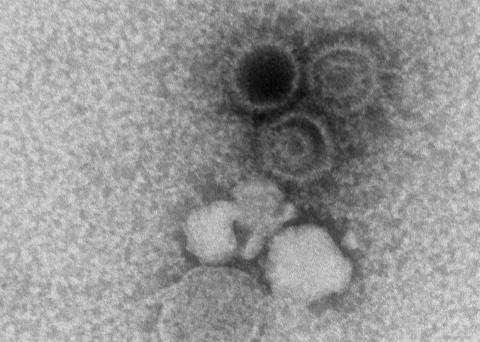When tested in a lab setting using human cells, a panel of experimental monoclonal antibodies (mAbs) that target various Epstein-Barr virus (EBV) sites prevented infection. Additionally, when tested in mice, one of the investigational mAbs offered nearly full protection against EBV infection and lymphoma.
 An electron microscopy image showing three Epstein-Barr virions. Image Credit: NIAID
An electron microscopy image showing three Epstein-Barr virions. Image Credit: NIAID
The findings are now available online in the journal Immunity. The study was conducted under the direction of researchers from the Walter Reed Army Institute of Research and the National Institute of Allergy and Infectious Diseases (NIAID), a division of the National Institutes of Health.
One of the most prevalent human viruses is EBV. The EBV virus goes dormant in the body after infection, although it can occasionally reawaken. It is the main cause of infectious mononucleosis and is linked to multiple sclerosis and certain tumors, including Hodgkin lymphoma.
Severe symptoms and complications from EBV infection are more likely to occur in persons with compromised immune systems, such as transplant patients, than in immunocompetent individuals. The virus cannot be prevented by an approved vaccine.
The scientists created a number of experimental mAbs that target two important proteins—gH and gL—located on the surface of EBV. It is known that the two proteins help EBV fusion with human cells and infection. Human B cells and epithelial cells, which line the throat at the initial site of EBV infection, were not infected by EBV when the investigational mAbs were evaluated in a laboratory context.
With the aid of sophisticated microscopy and X-Ray crystallography, the researchers were able to pinpoint numerous targetable locations of vulnerability on the virus in the structure of the mAbs and their two surface proteins.
One of the experimental mAbs, known as mAb 769B10, offered nearly full protection against EBV infection in mice. All examined animals were shielded from EBV lymphoma by the mAb as well.
According to the study’s findings, the investigational mAbs could be used alone or in combination to prevent or treat EBV infection in immunocompromised patients who are most at risk for developing severe EBV-related diseases. The authors emphasize that more study using mAb 769B10 is planned.
Source:
Journal reference:
Chen, W.-H., et al. (2022). Epstein-Barr virus gH/gL has multiple sites of vulnerability for virus neutralization and fusion inhibition. Immunity. doi.org/10.1016/j.immuni.2022.10.003